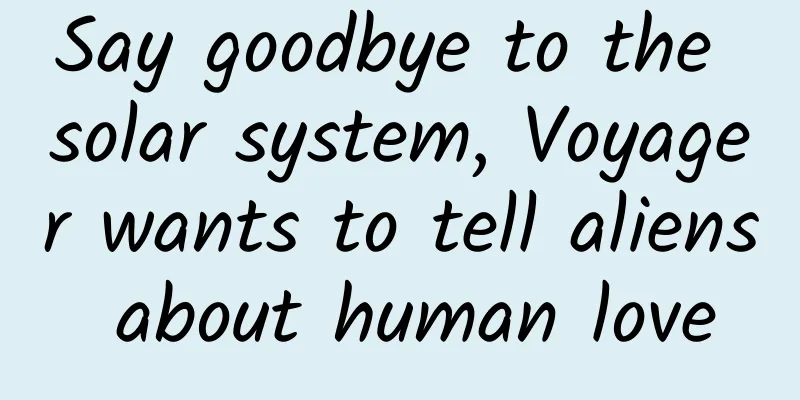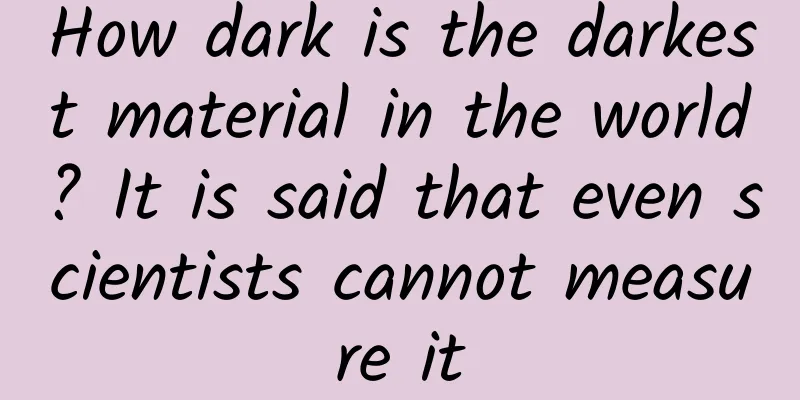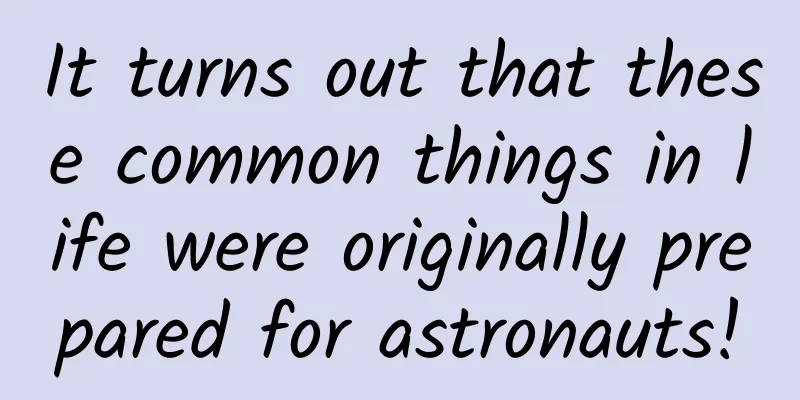Say goodbye to the solar system, Voyager wants to tell aliens about human love

|
I saw my love, I flew to her side, and held out a gift for her. It was a small piece of solidified time, with beautiful stripes on it, and it felt as soft as shallow sea mud. ——"The Three-Body Problem: Death's End" February 14, 1990, Valentine's Day. A human-made spacecraft is hurtling toward the edge of the solar system. The little battery power she had left was no longer enough to keep all the payloads on the spacecraft running. The camera that had seen countless new worlds was about to shut down. That day, she turned around and gazed lovingly at the place where she had set out. Six billion kilometers away, the ever-living, colorful blue planet was just a dim blue dot in the starry sky. After noting what the Earth looked like, she continued forward, preparing to say goodbye to the solar system. The famous "Pale Blue Dot" image shows the Earth as the blue dot in the lower middle of the red stripe on the right side of the image. This image has been given a wide range of cultural significance beyond science and is widely used. In the movie "The Wandering Earth 2", Chinese diplomats showed this image to officials from other countries. Source: NASA The spacecraft is called Voyager 1. Before she could no longer see, she wanted to remember what the Earth looked like and also kept a love story in mind, ready to tell the aliens the heartbeat of a 27-year-old girl in love. 01 Record the heartbeat of love Telling love stories to aliens Voyager 1 and Voyager 2 are a pair of "twin" spacecraft, and they are given the mission of pushing the final frontier of human space exploration in deep space. In the 1970s, the positions of Saturn, Jupiter, Uranus and Neptune allowed spacecraft to use leverage to fly and explore all the large planets other than Mars at one time. The Voyager spacecraft. Source: NASA The so-called leveraged flight is to use the gravity of celestial bodies to accelerate artificial spacecraft. If the aircraft is regarded as a walking traveler, then leveraged flight is equivalent to taking a free bus. It not only reduces the energy required for flight and the difficulty of launch, but also increases the flight speed of the spacecraft. The flight process of the two Voyager spacecraft. Source: NASA In addition to conducting scientific exploration, scientists have given Voyager another mission: to introduce humans to extraterrestrial civilizations. On board the two Voyager spacecraft are golden records containing digital information. Scientists hope that one day such a scene will appear in some corner of the universe: an extraterrestrial civilization captures the Voyager, decodes pictures, sounds and other information from the golden record, and learns about the Earth and humans from it. The gold turntable on board the Voyager. Source: NASA To accomplish this task, NASA assembled a multidisciplinary team. In addition to scientists and engineers, the team also includes popular science writers, artists and even editors of pop music magazines. People from all walks of life brainstormed and arranged rich content for the Golden Turntable. An image stored on Voyager's Golden Disc shows page 6 of Newton's magnum opus, "Mathematical Principles of Natural Philosophy." Source: NASA Aliens can see our scientific level from mathematics, physics formulas and DNA structure, and understand our technological capabilities from pictures of Titan rockets, astronauts, the Arecibo radio telescope, etc. They will even hear voice greetings in Mandarin Chinese: "How are you all? We miss you very much. Please come here and play when you have time." They can also enjoy the music created by humans, from Bach's graceful "Brandenburg Concerto No. 2" to our tranquil "High Mountains and Flowing Water". A gold turntable is mounted on the surface of the Voyager spacecraft. Credit: NASA 02 There is also a love story in the golden record And it’s about music In June 1977, Ann Druyan, the creative director of Golden Records, was having trouble choosing music. In her opinion, Chinese civilization has a long history of thousands of years, and the Golden Record should record some Chinese music. But unfortunately, she herself does not have the knowledge in this area. So, the 27-year-old called Carl Sagan, the head of the Golden Disc, hoping that the cross-border talent Sagan could provide some advice on this difficult problem. Sagan has multiple identities such as astronomer, popular science and science fiction writer. Hawking once invited Sagan to write the preface for "A Brief History of Time". In the previous two years, Druyan and Sagan were colleagues and friends, and gradually became familiar with each other at work. Druyan's call didn't go through at first, and Sagan's answering machine answered her. And when Sagan called back, something happened that even novels and movies could not imagine: during the dozens of minutes of phone calls, the two hearts quickly drew closer and sparks of love burst out. Druyan and Sagan, who had never held hands or hugged each other or had any intimate relationship before, decided to get married and accompany each other for the rest of their lives. Sagan and Druyan in their youth. Source: whalebonemag.com Some people call the feeling of being immersed in love "love brain" and quite "rationally" believe that this will lead to a series of tragic endings. However, the spark of love that burst out in just a few dozen minutes allowed Druyan and Sagan to stay together for more than 20 years until Sagan passed away. In 2019, Druyan, who is already 70 years old, can still clearly recall the excitement at that time: "Our homes, our work, our hearts and minds, our days and nights, remained happily one for the next twenty years until death did us part." The work of the two did not stop because of the arrival of love. Once, Druyan asked Sagan, "Can the extraterrestrial civilization that captures this spacecraft hundreds of millions of years later interpret the human's thoughts at that time from the brain waves?" Sagan's answer was, since we don't know, why not try? So, Druyan walked into the laboratory, connected many brain wave sensors to himself, and meditated for an hour. During this period, although Druyan tried her best to think about the various political and historical issues in the process of human development, she found that what was flashing in her heart was the joy brought to her by love. This brain wave is also the most special record on the Voyager's Golden Disc - telling the aliens about the heartbeat of love. Druyan's brain waves recorded the beautiful mood of love and stored them on the golden record player of Voyager. Source: NASA 03 Our Love Eternal record in endless time and space For man-made spacecraft, Voyager's flight speed has set a record. But facing the vastness of the universe, such a speed is simply not worth mentioning. According to calculations, it will take Voyager 40,000 years to reach the next star. In the process of traveling through space, cosmic rays released by various celestial explosions will continuously erode the information recorded on the medium. To this end, this copper-gilded turntable uses a special shielding treatment to ensure that the etched information can be preserved for hundreds of millions of years. The excitement that love brought to Druyan's heart also entered the long river of time. Following the trajectory of the Voyager spacecraft, it gained eternity in the infinite extension of time and space. Although Voyager brought the golden record, it did not carry a "phonograph" to play the record. In order to enable extraterrestrial civilizations to successfully decode the data, the team wrote instructions for the aliens to read the golden turntable on its surface, using the universal language of the universe - physics and mathematics. Explanation of the diagram on the surface of the Golden Disc. There is no text on the actual Golden Disc, because it is impossible for an extraterrestrial civilization to understand any language on Earth. We hope that they can understand what we mean by the physical processes and mathematical operations represented by the patterns. Source: NASA Perhaps you are asking at this point: Can aliens understand our instruction manuals? Don't be anxious, just listen to me slowly. Hydrogen is the most common element in the universe. In the diagram on the surface of the golden turntable, scientists tried to tell the aliens that the basic time unit in the instruction manual is the spin transition time of the hydrogen atom. Multiplying this time unit by the binary number given in the diagram is the rotation speed of the turntable when reading. The encoding waveform and rules of information can also be obtained from graphics. To let aliens know where Voyager came from, scientists marked the relative position of the solar system with respect to 14 pulsars in the universe. In the universe, the frequency of each pulsar is unique. Aliens who can read other information must be able to determine the position of the sun based on the pulsar frequency marked on the turntable. Compared with the evolution of celestial bodies and the universe, which often measures tens of thousands or billions of years, human life is not long, and the time we spend with our partner is even shorter. Both Druyan and Sagan felt this deeply as they imagined and planned for the future of Voyager. At the same time, they are both atheists and do not believe that people can be reunited in another world after death. Death separates two people, and everything is over, so they should cherish the time they spend together. Sagan and Druyan in middle age. Source: carlsagan.com Seven years after Sagan's death, Druyan said in an interview with reporters: "I don't expect that I can reunite with Sagan. What's important is that in our twenty years together, we have learned clearly how short and precious life is... Every moment we are alive and together is a miracle—not an inexplicable, supernatural miracle, but a generous and kind chance… It is a beautiful thing that in the universe we have found each other.” "Cosmos" is Carl Sagan's most classic popular science work. There is no data analysis or computational deduction in the book, but rather an examination of scientific cognition from the perspectives of history, art and philosophy. On the first page of the book, Sagan wrote: "To Ann Druyan. I am happy to have shared a planet and a time with Anne in the vastness of space and the endlessness of time." Words from the first page of Sagan's Cosmos. Source: e-book Cosmos 04 With the yearning for the distance and love, sailing far away The exploration of the two Voyager spacecraft opened up a whole new world for us. When passing by Jupiter and its satellites, they saw oceans, volcanoes and lightning outside the earth for the first time. Fine structures in Jupiter's atmosphere captured by Voyager. Source: NASA Volcanic activity on Jupiter's moons as captured by Voyager. Source: NASA As they passed by Saturn and its moons, they saw the breathtakingly fine structure of Saturn's rings and discovered that a moon called Titan had an atmosphere similar to that of Earth. False color photo of Saturn's rings taken by Voyager. Source: NASA When passing by Uranus and Neptune, they allowed people on Earth to clearly see the beautiful appearance of these two gas giants for the first time, and also discovered for the first time the special magnetic field of Neptune's "lying down". A full view of Neptune taken by Voyager. Source: NASA After breaking through the heliopause of the solar wind, they felt for the first time a new change in the oncoming wind and felt the blowing of interstellar matter... Density detection data when Voyager 1 passed through the heliopause. At the location indicated by the dotted line, she felt a denser wind coming towards her, and was in the blowing of interstellar matter. Source: Nature Astronomy Like any expedition to expand human boundaries, Voyager's journey was both magnificent and bumpy. During the launch of Voyager 1, the second stage of the Titan IIIE rocket suffered a fuel leak and did not provide sufficient thrust. Thanks to the Centaur upper stage, which was responsible for the subsequent orbital entry mission and had exhausted its spare fuel, Voyager 1 was able to be sent into the planned orbit. The Titan IIIE rocket that launched Voyager 1 took off at the moment of launch. This launch almost caused the death of Voyager 1. Source: NASA When Voyager 2 was launched, the vibration and rotation of the rocket caused the control system on Voyager 2 to fall into an endless loop, constantly switching back and forth between the primary and backup systems. Voyager 2 once became a rebellious child, refusing to follow any instructions sent from the ground. Fortunately, engineers located the fault in time and successfully solved the problem. When flying past Neptune, Voyager 2 was only 5,000 kilometers away from the surface of Neptune's north pole. Any slight deviation could cause it to deviate from its normal orbit due to Neptune's strong gravity. The control instructions from Earth took more than 200 minutes to be transmitted, making it difficult to correct the deviation in real time. With careful calculations and planning in advance, Voyager finally completed the flyby without any danger and continued to fly further into deep space... Looking up at the starry sky with your lover is a pleasant and romantic thing. As seen from Earth, Voyager 1 and 2 are located in the constellations Ophiuchus and Telescope respectively. Maybe on your next date, you can tell your lover this love story that reaches the stars and the sea. The changing position of Voyager 1 in the sky. The yellow line in the picture is the ecliptic. Source: NASA Tens of thousands or even hundreds of millions of years from now, when other civilizations in the distant universe try to understand what it means to be human, all they will see is the ripples in the hearts of lovers when they gaze into each other's eyes. On the tiny blue dot photographed by Voyager, people without blood relationship have established a new and closest relationship because of the emotion called "love", giving birth to new life and making this planet called "Earth" never silent or desolate. Successfully implementing a solar system edge exploration requires novel scientific problems, a deep technical foundation, and sophisticated design implementation; It requires outstanding courage and the efficient organization of many people with academic and engineering training, bringing together everyone's dedication and hard work into ultimate success. But the "original intention" of this seemingly serious and rational undertaking is actually people's yearning for the primitive and simple world far away: we want to go out and see what the unknown world is like. In a few years, the isotope fuel in Voyager's RTG batteries will be nearly exhausted, and the output power will be insufficient to maintain the most basic communications with the Earth. In the endless cold and loneliness of space, the travelers will never hear the sound from home again. But their yearning for the distance and love will give them eternal life among the stars. "The story originates from the simplest love words: My beloved." A heart-shaped impact crater on Mars, as captured by the Mars Global Surveyor (MGS) spacecraft. Source: NASA Note 1: This is a sentence from the postscript of the play "Amber" written by playwright Liao Yimei. The rehearsal of this play was directed by her husband Meng Jinghui. Note 2: The Voyager program consists of two spacecraft, Voyager 1 and Voyager 2. For the sake of brevity, this article will use "Voyager" when describing both of them. Note 3: Following the conventions in navigation and aviation, this article refers to spacecraft that explore space as "she". References: [1]https://www.inverse.com/article/38297-carl-sagan-birthday-ann-druyan-love-letter [2]https://www.nationalgeographic.com/science/article/dear-voyager-how-your-billion-year-journey-carries-true-love [3]https://blogs.scientificamerican.com/basic-space/voyager-a-binary-love-story/ Produced by | Science Popularization China Author: Li Huichao Harbin Institute of Technology (Shenzhen) Producer|China Science Expo Submitted by: Computer Network Information Center, Chinese Academy of Sciences The cover image and the images in this article are from the copyright library Reproduction of image content is not authorized |
Recommend
4 content systems that must be built for community operations
In a complete community operation, no matter what...
How to plan an event from 0 to 1?
1. Cognition: The first question to think about b...
What are the advantages and benefits of renting a large bandwidth server?
What are the advantages and benefits of renting a...
What substance is fire and what form is it in?
Objects in nature generally exist in three forms:...
Daokun has no source of goods. Kuaishou store live broadcast technology, the new account will be live on the same day to place an order operation process [paid article]
Daokun has no source of goods. Kuaishou store liv...
Tesla, BYD and Xiaopeng, recommendations for their long-range new energy vehicles: Which one is right for you?
After my country announced a reduction in subsidi...
Have you ever taken one of these high-tech buses?
The environment in big cities is getting worse an...
Campus mobile Internet: a tough piece of fat to swallow
In the minds of entrepreneurs in the mobile Inter...
Analysis of GuangDianTong information flow optimization techniques!
Guangdiantong is one of Tencent’s two major infor...
Can kelp be used to make pork rib soup? It's too small! It can also "capture" carbon dioxide!
Humans have never stopped exploring the ocean. Ho...
Oracle: New TikTok board will have 4 Americans, possibly including Masayoshi Son
On Wednesday local time, Maria Bartiromo, anchor ...
This time, it’s not just about going to the North Pole! Chinese scientists realize their dream of reaching the North Pole!
If someone has visited the North Pole and checked...
After reviewing Google’s “Guess the Painting” app, I found 5 reasons why it became so popular!
Traffic acquisition of mini programs has been the...
With current human science and technology, can we completely destroy the earth?
This article is based on answering similar questi...









